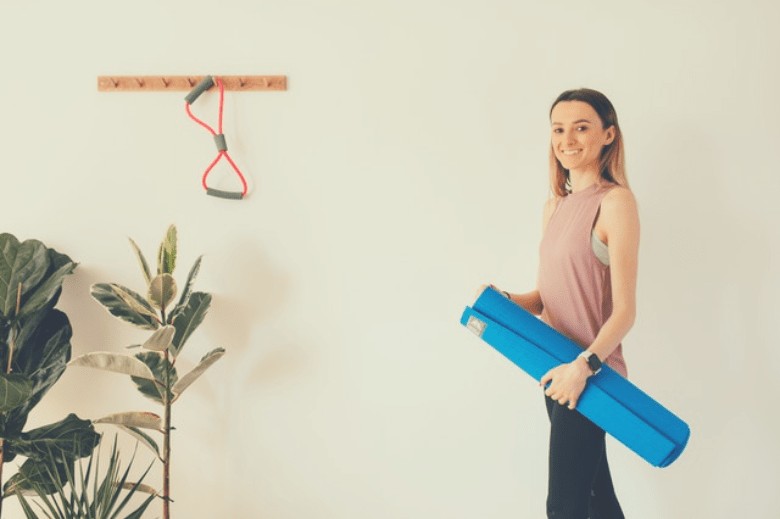We all know that running is good for our health, but have you heard of the benefits of running in place?
I know, it’s not something you hear everyday, but hear me out.
We’ve heard the lectures and seen the studies, and we know that a little bit of cardio can go a long way.
However, if you live in a crowded area that isn’t very runner-friendly, it can be difficult to start a new habit.
Read on for how you can get started running at home and a recommendation for how to make it fun.
> > Short on time? Check out our recommendation here < <
Benefits of Running

As mentioned above, most of the benefits of building up a regular running routine are fairly well-known.
However, it never hurts to have these benefits laid out at a glance, especially if you’re trying to convince yourself to start something new.
As a general rule, the main benefits of running are related to the health of your heart and your lungs. This includes benefits like:
Weight Loss
Any physical activity will improve your ability to lose weight, and running is no exception.
Just thirty minutes of activity per day, five days a week, can go a long way towards helping you shed those pesky pounds.
While this may help you boost your self-confidence, it can also help fight off several serious health conditions that are often associated with increased weight gain and are increasingly common in the modern world.
Better Core Strength
Running is a full-body exercise, which means that the benefits don’t stop at toughening your legs.
The steady, repetitive motion of running can tighten your core muscles and help strengthen your stomach and back.
Aside from the potential for a set of killer abs, a strengthened core can greatly improve both your posture and your respiratory health!
Steady Blood Pressure
Research shows that running on a regular basis can improve the amount of “good cholesterol” in your bloodstream.
The good cholesterol can improve your overall circulatory health and give you a healthy level of blood pressure.
Lowered Risk of Disease
A regular running habit can significantly reduce your risk of potentially life-threatening diseases.
Strokes, cardiac conditions, and other health complications associated with high blood pressures and relatively high weight are some of the most serious threats to the average 21st-century person’s health.
By establishing a healthy workout routine, you can reduce or even eliminate your chances of developing these seriously scary disease.
Improved Mental Health
While running can certainly help heal and hone your body’s strength, it can also do the same for your mind!
After only a few minutes of exercise, your mind starts to secrete chemicals known as endorphins.
Endorphins are the primary chemical agents responsible for lifting your mood and giving you a more hopeful outlook on life.
Obviously running should never be used as a cure-all panacea for all mental illnesses, but it can help your body obtain the tools that your mind needs to fight off depression, anxiety, and other common mental afflictions.
Dangers of Running
Unfortunately, while the benefits of running as exercise are many, there are still some associated risks.
If you’ve ever tried to start running out of the blue, you probably know how uncomfortable it can be.
Beyond just surface-level discomfort, some of the risks associated with running include:
Inflammation
When you’re first starting out, running can put a tremendous amount of stress on the muscles of the legs and core.
If you’re not getting sufficient rest and proper nutrition, this can lead to a painful level of swelling and inflammation.
The main problem with inflammation as a result of running is that it requires rest in order to properly heal.
Taking time to rest right at the start of your running routine can be a frustrating roadblock to future exercise goals.
Cardiac Arrest
When you first start out, it’s imperative that you start small and build up to longer distances.
If you try to tackle too much too fast, you run the risk of putting too much strain on your body.
Cardiac arrest isn’t very common in runners, but the effort of pumping enough blood to keep your legs in fighting shape can put an enormous amount of pressure on your heart and lungs.
In some cases, this could have catastrophic results like a cardiac event.
Weakened Immune System
Especially when you’re just getting started, running can actually weaken your immune system.
The sheer amount of stress you’re putting on your body can tax your whole system, and your immune system may take a bit of a hit in order to compensate.
Once you’ve established a running routine, this risk should be greatly reduced, but you still need to make sure you’re getting plenty of rest and nutrition when you’re just starting out.
Bone Conditions
Improper running puts a great deal of strain on the bones of your legs, ankles, and feet.
Make sure you’re keeping proper form when you run to avoid putting any additional stress on these at-risk areas.
External Risks
At the most basic level, running on the sidewalk or at a park has some more practical causes for concern.
Even if you live in the safest neighborhood on the planet, you still need to be on the lookout for cars, pets, or even other pedestrians who could put you at a higher risk of injuring yourself.
Does Running in Place Still Work?
If you want to get started building up a running routine but want to avoid some of the risks associated with trail running or street running, why not try just running at home?
Even if you don’t have a treadmill, running in place can get you some of the same benefits as “free” running, without the same level of stress.
Most of the advantages associated with running come from the elevated heart rate.
Jogging in place in your own living room can still greatly elevate your heart rate into the cardio range, which means that you’ll still profit from a regular routine without having to worry about finding a park to run at.
Running in place has become more and more popular as an alternative to traditional running regimes.
Video games like WiiFit have even turned the exercise into a game, but you don’t need a bunch of gaming equipment to work out at home.
Again, the key to getting a good workout lies in the heart rate and the time.
If you’re planning to start running at home, focus on keeping your heart rate up and also on sustaining the same level of effort for the duration of your run.
Mayo Health Clinic recommends at least thirty minutes of moderate exercise per day. While this task may seem daunting at first, start small and work your way up.
Make sure you’re running at roughly the same speed, as this will allow your body to reach a point of sustained energy burn-off and cardiac strain.
Potential Risks of Running in Place
Of course, as with any other exercise, there are still some potential risks associated with running in place.
Probably the most crucial thing to keep in mind is the importance of a good form.
Everyone’s stride is naturally different, so there’s nothing wrong with a running style that “looks funny” as long as it keeps your heart rate in a good place and feels comfortable.
However, in a traditional running regiment, you interact more with the pavement and the world around you, which lets you adjust your stride and your running form in order to protect your ankles and legs.
When running in place, you don’t have to worry about some of the same outside factors. As a result, it can be easy to slip into a running style that actively damages your knees, ankles, and legs.
Fortunately, there are plenty of resources available to help correct your form.
Make sure that the way you run isn’t actively hurting your overall health, and you should be perfectly safe to run in place for the duration of your exercise!
One way to make sure that your form is both comfortable and sustainable is to start small and work up to a full thirty-minute workout.
If you’re not already working out, any little bit of activity is an improvement, so don’t worry if you’re not ready to run a full ultramarathon right away!
On a more practical level, depending on where you live, jogging in place may prove to be a source of irritation from any downstairs or next-door neighbors.
In order to get avoid the inevitable (and slightly awkward) conversation, try jogging on a rug or carpet that will help to muffle the noise in addition to providing a little bit of padding for your joints!

Why Bother?
So why should you even try running at home?
Obviously there are a lot of health benefits to running in general, but why should running in place at home be any more useful than running at a gym on a treadmill?
Again, the benefits of running in general are fairly well-known, but the main things to consider when thinking of running at home include:
Time
One of the biggest excuses most of us give for not working out on the regular is that we simply don’t have the time.
Depending on where you live, it can be a major pain to drive to either a gym or some sort of running track.
If you’re running at home, you don’t have to worry about tracking down the perfect place to run, signing up for a gym membership, or driving or walking to and from your running spot every day.
Even if you’re only saving a few minutes either way, those few minutes can be put to good use as a regularly scheduled part of your daily workout routine.
By jogging in place at home, you can save yourself some time, which gives you more time to run!
Cost
The time cost isn’t the only cost associated with a gym membership. If you’re looking for ways to workout in a controlled environment, but you don’t want to spend a lot of money on a pricey membership, running at home can be a great way to burn calories without burning cash.
You may still have to spend on workout gear and equipment, but the overall cost associated with working out at home is so much lower than it would be pretty much anywhere else!
Weather
Depending on where you live, the weather outside your home may be one of the strongest arguments for working out in your living room.
Running in extreme hot or cold environments can shock your system beyond what you want for a good workout and put you at risk for some nasty side effects.
Regardless of where you call home, jogging in place at your house can go a long way towards keeping you protected from the elements and giving you the motivation to get up and work out
Is There Anything You’ll Need?
As a general rule, all you really need to get started running is a good pair of shoes and a set of comfortable clothes.
However, if you’re running at home, you need to pay special attention to your knees and ankles as you work to get the perfect running form.
Your knees may be the first place to start showing strain when you run, which makes it absolutely vital that you find a pair of shoes that supports your whole leg.
Make sure your shoes provide at least half an inch of space in front of your toes and look for a pair that supports the arch of your foot.
If you have high arches, shoes that are too tight will result in your body going to extreme lengths to compensate for the discomfort.
This can cause tremendous amounts of strain in your knees, ankles, and hips, so make sure you find a pair of shoes that accommodate the shape of your foot.
As for clothes, whatever makes you feel comfortable and is easy to work out in is a good choice.
One of the many benefits of working out at home is that you don’t have to worry about appearances, so wear whatever you love!
Overall, starting a new running routine can be something of a daunting task.
There are so many routes and options to consider, and the very act of starting up a new routine can sometimes be overwhelming.
Fortunately, running at home provides a simple, easy alternative to hitting the busy streets.
While you may have to do a little bit more research or work a little bit harder to make sure that your form is correct, you can still get all of the benefits from running in your apartment or in your home that you would get out on the streets or on a running trail.
Take the time to hit your stride, and soon you’ll be running for miles without stepping out the front door!
We Recommend – MoonRun CONNECT
If you’re looking for a way to make running in place at home fun, then you’ll definitely want to check out the MoonRun CONNECT. If you ever find yourself stuck at home and are still looking to get some cardio training in, this fitness exercise device is something you’ll definitely want to consider. Not only is it easy to store and put away, but you won’t have to deal with big bulky machines like a treadmill taking up room in your home. If you want to learn more about this treadmill alternative, check out our full review of the MoonRun Connect.




